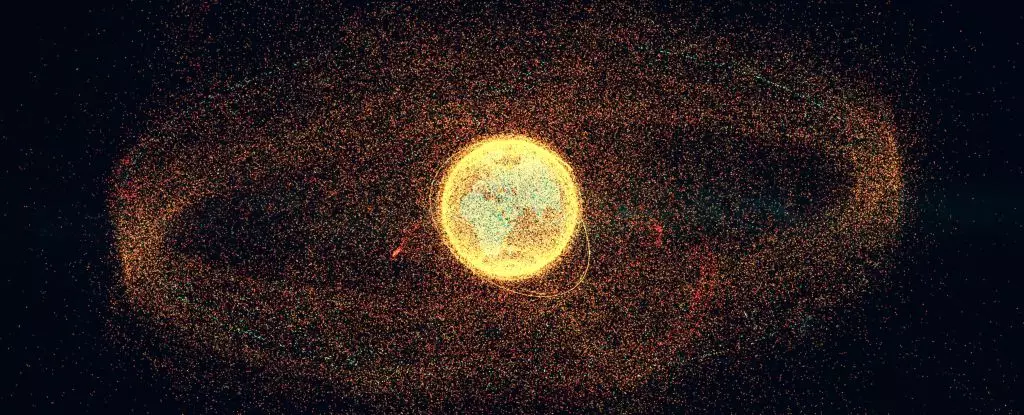

With every successful satellite launch, we inch closer to a looming disaster in the cosmos. As highlighted in the European Space Agency’s (ESA) annual Space Environment Report, the crisis of space debris is not just a distant theoretical problem—it is an urgent and escalating reality. The rapid proliferation of satellites, outpacing our ability to responsibly dispose of them, leads to a point where our orbits could become a treacherous minestrone of broken spacecraft, defunct satellite fragments, and the occupational hazard known as space debris. The Kessler Syndrome, where unchecked collisions unleash further debris, is not merely a cautionary tale but a plausible scenario we are hurtling towards.
According to ESA data, we are currently maintaining a staggering count of around 40,000 objects in orbit. Out of these, only about 11,000 are functional satellites. The sheer volume of junk—54,000 pieces larger than 10 centimeters—alongside an estimated 1.2 million fragments measuring between 1 and 10 centimeters, presents a dire picture of our celestial backyard. Small pieces, often overlooked, can wreak havoc on operational satellites, including crucial instruments like the Hubble Space Telescope and the International Space Station. One might think that such small objects bear minimal threat, but the velocity at which they travel transforms these tiny pieces into devastating projectiles.
The concept of Kessler Syndrome was first introduced in 1978 by NASA scientist Donald J. Kessler, articulating the potential for a catastrophic cascade of collisions in low Earth orbit (LEO). The beauty of space is that it is largely pristine. However, the consequences of human activity threaten this purity. Imagine a sequence where one collision generates more debris that collides with another object, continuing the cycle ad infinitum. While we have not yet reached this catastrophic tipping point, the question remains: how long can we ignore this ticking time bomb? Current projections suggest that even ceasing all launches today will not remedy the debris problem due to fragmentation events that proliferate space junk faster than we can clean it up.
Recent reports indicate non-collisional fragmentation events, such as explosive failures in satellites and rocket stages, are current leading contributors to debris growth. In 2024 alone, there were 11 notable fragmentation events that produced over 2,600 pieces of hazardous debris. Unlike controlled re-entries where spacecraft are intentionally directed to burn up in the atmosphere, these uncontrolled occurrences inevitably add to the chaos of the debris field, making the situation more precarious.
Despite the grim assessment, glimmers of hope can be found. There has been a discernible increase in controlled atmospheric re-entries, which is a positive stride towards tackling the problem. ESA reports that about 90% of rocket bodies in low Earth orbit are now adhering to the 25-year re-entry standards set forth before 2023, with significant compliance for more stringent policies adopted recently. This proactive approach underscores the idea that saving space does not solely rely on ceasing launches but on responsibly managing the lifecycle of satellites and rocket bodies.
However, this is merely the beginning. A systemic cleanup strategy is vital, yet it presents an intricate web of global challenges that require unprecedented cooperation among nations. Cleaning the space around Earth demands collaborative efforts and innovative technologies, starting with initiatives aimed at capturing and deorbiting space junk. Various startups and governmental agencies are cementing their initiatives, vying to be the pioneers of space cleanup, but these missions are riddled with technological and financial complexities.
What makes the proliferation of space debris a particularly harrowing issue is its global nature. Debris does not discriminate based on national borders; the actions and inactions of one country can endanger the interests of another. Thus, the narrative evolves beyond a mere technical issue into one of global responsibility. The space-faring nations must foster a culture of accountability and put policies into place that not only regulate launches but also implement robust debris mitigation measures.
Education and advocacy also play crucial roles in shaping public and political opinion to prioritize space sustainability. As we embark on missions to explore Mars and beyond, we must simultaneously acknowledge and address the challenges closer to home. Our aspirations in space exploration require responsible stewardship of our orbital environment.
The countdown is on, and if humanity is to continue reaping the benefits of satellite technology while avoiding catastrophe, we must act decisively and collectively. Reshaping the narrative from one of complacency to one of proactivity will be crucial in ensuring that our paths in orbit remain both safe and sustainable for generations to come.
In the world of pharmaceuticals, innovation often hinges on finding new compounds that can lead…
In the heart of the Amazon basin, drastic climate changes present an alarming reality that…
Air fryers have rapidly surged in popularity, captivating home cooks and culinary enthusiasts alike. When…
In an era where technology and social media reign, the importance of sleep often takes…
In an era where environmental consciousness is paramount, the maritime industry has long been scrutinized…
Radionuclides, often relegated to discussions surrounding nuclear energy and radioactive waste, have far-ranging implications for…
This website uses cookies.